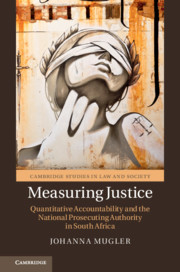 Measuring Justice
Measuring Justice Book contents
- Measuring Justice
- Cambridge Studies in Law and Society
- Measuring Justice
- Copyright page
- Dedication
- Contents
- Acknowledgements
- Abbreviations
- Legislation – Statutes
- Introduction
- I From Apartheid Administrators to Lawyers of the People: A History of Accountability inside the South African Prosecution Authority (1948–2018)
- 2 Ethnographic Research in a Multi-Local Organisation: Access, Challenges and Methods
- 3 ‘Stats Talk’ and Alternative Expressions of Accountability: NPA Lower Court Prosecutors at Work
- 4 No Fear of Numbers: Reactivity and the Political Economy of NPA Performance Measurement
- 5 At the Top of the NPA
- 6 Lies, Damned Lies and Statistics
- Concluding Remarks
- Bibliography
- Index
- Cambridge Studies in Law and Society
6 - Lies, Damned Lies and Statistics
Making Sense of Misleading or Imperfect NPA Conviction Rates
Published online by Cambridge University Press: 22 June 2019
- Measuring Justice
- Cambridge Studies in Law and Society
- Measuring Justice
- Copyright page
- Dedication
- Contents
- Acknowledgements
- Abbreviations
- Legislation – Statutes
- Introduction
- I From Apartheid Administrators to Lawyers of the People: A History of Accountability inside the South African Prosecution Authority (1948–2018)
- 2 Ethnographic Research in a Multi-Local Organisation: Access, Challenges and Methods
- 3 ‘Stats Talk’ and Alternative Expressions of Accountability: NPA Lower Court Prosecutors at Work
- 4 No Fear of Numbers: Reactivity and the Political Economy of NPA Performance Measurement
- 5 At the Top of the NPA
- 6 Lies, Damned Lies and Statistics
- Concluding Remarks
- Bibliography
- Index
- Cambridge Studies in Law and Society
Summary
When the old apartheid prosecuting authority was transformed and the first new National Prosecuting Authority was established in 1998, one of the main objectives of the new NPA leadership was to legitimise the power of prosecutors in the eyes of those they had until recently suppressed. They envisioned prosecutors, as I mentioned before, as ‘lawyers for the people’ (Barrell and Soggott 1998; Schönteich 2001: 1). To be accountable became an important and desirable good in that transformation process.
Are the NPA and the prosecutorial profession accountable today? Are they more accountable than before 1994? While I showed in Chapter 1 that the accountability mechanism governing the NPA and its employees has been clearly diversified and intensified since 1998, I also argued at various stages of this book that whether accountability has been rendered depends to a large extent on the involved actors’ understandings of the concept.
- Type
- Chapter
- Information
- Measuring JusticeQuantitative Accountability and the National Prosecuting Authority in South Africa, pp. 140 - 164Publisher: Cambridge University PressPrint publication year: 2019
